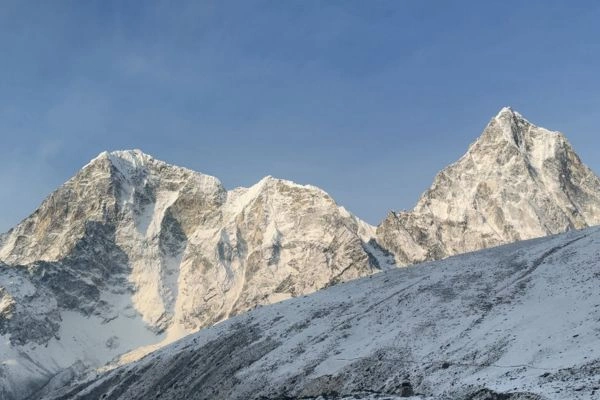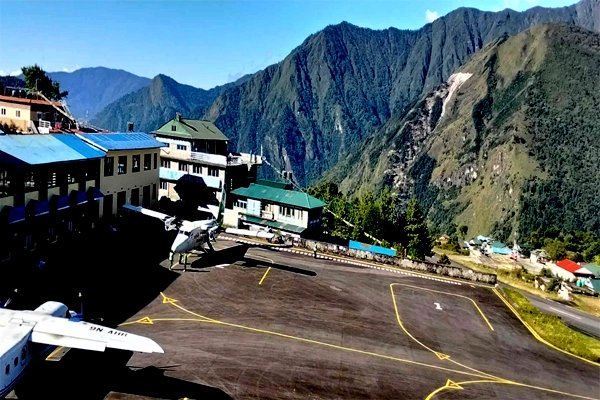Nestled amidst the towering peaks of the Himalayas, the Everest Base Camp is an iconic and awe-inspiring trekking journey that takes adventurers through the heart of the Himalayas, offering an unparalleled opportunity to witness the grandeur of the world's highest peaks and immerse themselves in the unique culture of the Sherpa people.
Embarking on a journey to this iconic destination is not only a physical feat but a spiritual experience that leaves an indelible mark on the soul. In this guide, we'll take you through the awe-inspiring route that leads to the base camp of the world's highest peak, offering insights, tips, and a glimpse into the breathtaking landscapes and vibrant culture that await.
Different route variations to reach the Everest Base Camp
Reaching Everest Base Camp offers a range of route variations to suit diverse preferences, timeframes, and levels of experience. The well-trodden standard route from Lukla is favored for its convenience and remarkable scenery, starting with a flight from Kathmandu. Alternatively, the classic route via Jiri provides a more traditional and culturally immersive experience, encompassing a gradual altitude gain.
Adventurers seeking a unique twist can opt for the Gokyo Lakes and Renjo La Pass route, which diverges at Namche Bazaar and unveils breathtaking landscapes. The daring might take on the Three Passes Trek, a rigorous option entailing three high passes and unparalleled panoramas.
Helicopter returns from Everest Base Camp accommodate those with time constraints, while the Makalu Base Camp extension appeals to those craving more challenge and remoteness. The Arun Valley route presents a quieter and less crowded journey.
With these variations, trekkers can tailor their Everest Base Camp experience to align with their aspirations, from traditional authenticity to off-the-beaten-path exploration.
Standard Trekking Route from the Lukla
The standard route to Everest Base Camp from Lukla is undeniably the most popular pathway. A large number of trekkers opt to fly directly to Lukla, drawn by the allure of this well-trodden trail that promises unparalleled views and a profound connection with the Himalayas. This route begins with a thrilling flight from Kathmandu to Lukla, where adventurers are welcomed by sweeping aerial views of the Himalayan landscape.
From Lukla, the trail winds its way through ancient villages and verdant forests, tracing the course of the Dudh Koshi River. As you traverse the path to Phakding, situated at 2,610 meters, the journey takes its initial steps toward the base camp.
Continuing the ascent, the trail leads to Namche Bazaar, a vibrant Sherpa hub at 3,440 meters. Here, bustling markets and glimpses of the world's highest peaks welcome you to the heart of the Khumbu region. An acclimatization day follows, guiding trekkers on a hike to Syanbuche at 3,880 meters, allowing bodies to adjust gradually to the increasing altitude.
Leaving Namche behind, the trail unfolds to Tyengboche at 3,860 meters, home to the renowned Tengboche Monastery. This leg of the journey offers panoramic views that encompass Everest's majestic landscape. Dingboche, situated at 4,410 meters, marks the next destination on the trek. The alpine terrain and ever-changing vistas create an awe-inspiring backdrop as you venture deeper into the Himalayas.
Acclimatization takes precedence once again in Dingboche, offering a much-needed opportunity to adjust before ascending further. The journey to Lobuche at 4,910 meters unveils rugged terrain and pristine beauty, setting the stage for the culmination of the trek.
The most anticipated part of the journey arrives with the trek to Everest Base Camp at 5,364 meters. Standing at the foot of the world's highest peak is a monumental experience that leaves trekkers in awe. After absorbing the grandeur of the surroundings, the return to Gorakshep at 5,125 meters provides a reflective moment to process the accomplishment.
An early morning ascent of Kalapatthar at 5,545 meters rewards trekkers with panoramic sunrise views over Everest—a fitting climax to the journey. The trek then continues to Pheriche before retracing steps back to Namche Bazaar and eventually Lukla.
In this manner, you can reach the Everest Base Camp in just 12 days with the most amazing memories printed on your soul forever.
Classic way to reach the Everest Base Camp via Jiri
The journey to the Everest Base Camp is a dream for many adventure enthusiasts, and while the Lukla flight route is the more common choice, the classic path via Jiri offers a truly exceptional and authentic trekking experience. This alternative route is known for its purity and immersive nature, taking trekkers on a longer, more gradual journey that allows for better acclimatization and a deeper connection with the region.
What sets the Jiri route to reach the Everest Base Camp apart is its departure from the conventional trekking norm. Instead of a quick flight to Lukla, trekkers following this path begin their adventure with a scenic drive from Kathmandu to Jiri. This overland journey not only adds a touch of excitement but also helps trekkers transition from the urban environment to the serene landscapes of the Solu Khumbu region.
The route meanders through picturesque villages, terraced fields, and lush forests, offering an unfiltered view of the local way of life. This immersion in the local culture and traditions adds depth to the journey, allowing trekkers to forge meaningful connections and gain a deeper appreciation for the region.
One of the most significant advantages of the Jiri route is its extended duration. Unlike the Lukla flight option, this path demands more days of trekking, which not only aids in gradual acclimatization but also allows trekkers to take their time and fully absorb the awe-inspiring scenery. Trekkers can savor leisurely breaks to capture panoramic views, interact with friendly locals, and create lasting memories.
In conclusion, the classic way to reach the Everest Base Camp via Jiri offers a distinct and enriching trekking experience that stands apart from the typical route. With its extended journey, deliberate acclimatization, and authentic interactions, this path resonates with those who yearn for a deeper connection with the Himalayan region. Choosing the Jiri route means embracing a more deliberate pace, immersing oneself in local culture, and savoring every moment of the trekking adventure.
Here’s our 20-day Everest Base Camp Trek via Jiri package.
Which route is better to reach the Everest Base Camp?
The choice between the standard route from Lukla and the classic route via Jiri to reach Everest Base Camp depends on your preferences, priorities, and the type of experience you're seeking. Each route has its own unique advantages and considerations. Let's break down both options to help you make an informed decision:
Standard Route from Lukla:
Advantages:
Convenience: The Lukla route starts with a short flight from Kathmandu to Lukla, saving you time and allowing you to reach higher altitudes quickly.
Time Efficiency: This route is faster and more suitable for those with limited time, as it takes fewer days to reach Everest Base Camp compared to the Jiri route.
Scenic Flight: The flight to Lukla offers stunning aerial views of the Himalayas, providing a unique perspective on the region.
Considerations:
Altitude Acclimatization: The rapid gain in altitude due to the flight can increase the risk of altitude sickness for some trekkers, even though you have a day to acclimatize in Namche Bazaar.
Crowds: The Lukla route is more popular, leading to higher trekker traffic on the trails and more crowded teahouses during peak seasons.
Classic Route via Jiri:
Advantages:
Authentic Experience: The Jiri route offers a more gradual ascent, aiding in better altitude acclimatization and reducing the risk of altitude-related issues.
Unspoiled Scenery: This route takes you through remote villages, forests, and terraced fields, providing a more serene and unspoiled trekking experience.
Cultural Immersion: The longer trek allows for deeper interaction with local communities and a more immersive cultural experience.
Extended Stay: If you have the time and inclination to spend more days in the mountains, the Jiri route offers an extended and immersive journey.
Considerations:
Time Commitment: The Jiri route requires more days on the trail due to its longer approach, making it more suitable for trekkers with extra time to spare.
Physical Endurance: The Jiri route involves more trekking days and longer distances, which may require better physical fitness and endurance.
Choosing the Right Route:
If you prioritize convenience, and time efficiency, and are comfortable with a shorter acclimatization period, the standard route from Lukla might be the better choice for you. On the other hand, if you're seeking a more authentic, immersive, and extended trekking experience with better altitude acclimatization, the classic route via Jiri might be more appealing.
Ultimately, the "better" route depends on your personal preferences, physical condition, available time, and the type of adventure you're seeking. Both routes have their merits, and whichever one you choose, you're sure to be rewarded with breathtaking scenery and an unforgettable journey in the Everest region.




